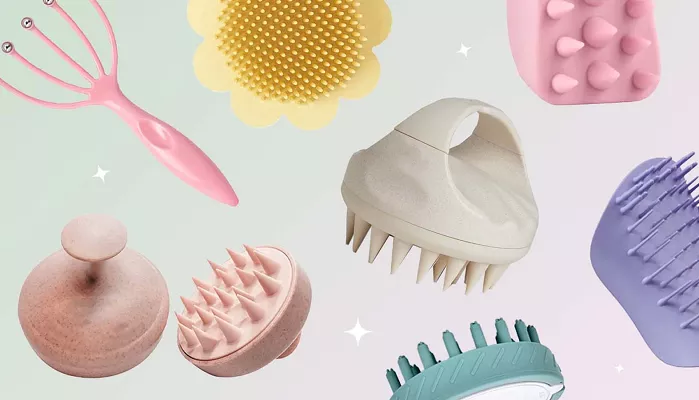Healthy, vibrant hair begins beneath the surface — at the scalp. According to Dr. Craig Ziering, a board-certified dermatologist and renowned hair transplant surgeon, the foundation for strong, thick hair lies in the follicles embedded in the scalp. Supporting scalp health, he says, is essential for minimizing breakage, thinning, and hair loss.
A growing number of dermatologists and trichologists now recommend incorporating scalp massagers and brushes into daily hair care routines. These simple, affordable tools are designed to stimulate circulation, remove buildup, and improve overall scalp condition — all of which can enhance hair health and support long-term growth.
The Science Behind Scalp Massage
Regular scalp stimulation can lead to thicker hair. A 2016 study found that just four minutes of daily scalp massage over six months resulted in increased hair thickness in men. Similarly, a 2019 study showed that massage could aid in managing alopecia. The gentle pressure applied during a massage stretches follicle cells, potentially encouraging them to produce stronger, fuller hair strands.
“You don’t need an expensive tool to get started — even your fingers can do the job,” says Dr. Azza Halim, a board-certified physician who specializes in topical scalp treatments. “The goal is to promote circulation, not to scrape or irritate the skin.”
Brushes vs. Massagers: What’s the Difference?
According to experts, both scalp brushes and scalp massagers serve valuable, but slightly different, purposes:
Scalp brushes have thin bristles and are best for exfoliating the scalp, removing dead skin cells and product buildup, and distributing natural oils through the hair.
Scalp massagers, with their thicker silicone bristles, are better suited for use during shampooing. They help products penetrate more deeply and increase blood flow during the cleansing process.
Dr. Margarita Lolis, a board-certified dermatologist at Schweiger Dermatology Group, advises choosing tools with soft, malleable bristles to avoid irritation and follicle trauma. “Silicone bristles are ideal — firm enough to be effective, but gentle enough to protect your scalp,” she says.
Choosing the Best Tool for You
When selecting a scalp brush or massager, consider your hair type and scalp condition.
“For fine hair, you want a tool that doesn’t tug or break strands,” says Lolis. “For oily or flaky scalps, choose one with firmer bristles that can exfoliate without being too harsh.”
Among the most recommended tools by dermatologists and scalp experts:
Top Scalp Brushes
Manta Scalp Brush: Known for its bendable bristles that mold to your scalp’s shape. Gentle on all hair types and suitable for those with extensions.
Tangle Teezer Scalp Exfoliator and Massager: A dual-action tool with long, flexible bristles for exfoliation and shorter ones to stimulate circulation.
Jupiter Scalp Brush: Firm but gentle bristles make it ideal for oily hair and dandruff-prone scalps. Its compact design is great for travel.
Top Scalp Massagers
Ocoa Scalp Massager: Favored by those with fine hair for its ultra-soft bristles that reduce breakage.
Leonor Greyl Massaging Scalp Brush: Perfect for in-shower use, combining product penetration with a soothing massage.
Maxsoft Shampoo Brush: A budget-friendly pick that works well with shampoo or scalp oil.
Diane Shampoo Massage Brush: Gentle silicone bristles make it ideal for textured hair and users with acrylic nails.
Comfier Cordless Hair Scalp Massager: A vibrating option with adjustable modes, popular among patients at NYU Grossman School of Medicine.
Best Hair Brushes That Support Scalp Health
Don’t overlook your regular brush either. “Using the wrong brush can rip hair and strain follicles,” warns Halim. Instead, consider these scalp-friendly options:
Tangle Teezer Naturally Curly Brush: Designed for textured hair with a wide surface to minimize scalp tension.
Wet Brush Pro Detangler: A classic brush with rubber-tipped bristles that glide smoothly through hair and offer light scalp stimulation.
Expert Hair Health Tips for Using Scalp Tools
Frequency: Lolis recommends brushing your scalp twice daily — morning and evening — to distribute oils and maintain scalp balance. Massagers can be used 1–2 times a week, or more frequently for a relaxing self-care ritual.
Dry or Wet?: Most scalp brushes and massagers can be used on both dry and wet hair, but experts advise using massagers in the shower for best results.
Check the Bristles: Whether it’s a brush or massager, soft, flexible bristles are non-negotiable. “If it feels like scraping or causes discomfort, it’s too harsh,” says Lolis.
Experts agree: adding a scalp brush or massager to your routine is one of the easiest, most affordable ways to improve your hair health. With benefits that include enhanced circulation, product absorption, and reduced buildup, these tools are more than a trend — they’re a smart investment in your long-term hair care.
As Atoyebi puts it: “If you want healthier hair, start at the root — literally.”
Related Topics:
- Scalp Cooling Therapy Offers New Hope for Chemotherapy Hair Health
- Typebea’s 3-in-1 Dry Shampoo: Cleanse, Volume & Hair Growth Boost
- Does Creatine Cause Hair Loss? Experts Say No


